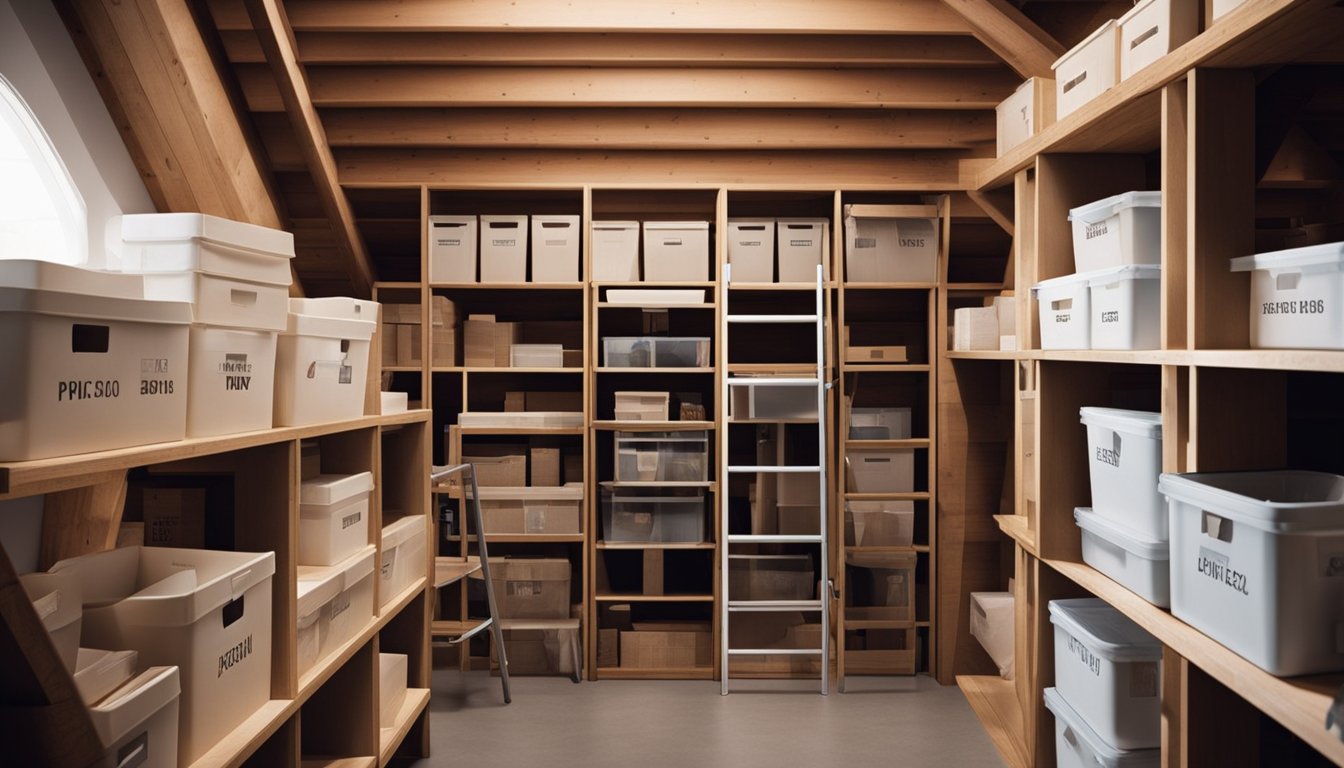Late updated: 09 Aug 2024 14:08
Written by: Oliver Bennett
Maximising Attic Space for Extra Storage in UK Homes: Practical Tips and Ideas
Attics often become the forgotten spaces in our homes, neglected and underutilised. Yet, with the right approach, you can transform your attic into a practical storage solution, increasing the usable space in your home. By implementing some clever design hacks, we can help unlock the hidden potential of these areas.

Shelving is a key aspect of any effective attic storage plan. Floating shelves, for instance, are an excellent way to maximise vertical space without adding bulk. Additionally, consider using under-eaves storage for drawers or sliding boxes, perfect for keeping out-of-season clothing and other less frequently used items out of sight but easily accessible.
Another smart choice is integrating elements like clothes rails where the ceiling height permits. For a more polished look, add in a dressing table or even wallpaper the ceiling to provide a sense of height and sophistication. These small touches not only boost storage capacity but also make the attic a more inviting part of the home.
Key Takeaways
- Maximise vertical space with floating shelves and clothes rails.
- Use under-eaves storage for drawers and boxes.
- Small design elements enhance both functionality and aesthetics.
Designing Your Attic Storage Solution
Maximising attic space for storage requires a well-thought-out approach. Start by considering planning permissions, assessing the space's suitability, selecting appropriate furniture, implementing smart storage features, and ensuring health and safety.
Understanding Planning and Permissions
When designing attic storage solutions, we must first determine if planning permission is required. In the UK, typical storage adjustments in an attic don't usually need planning permission. However, larger changes, like loft conversions, may require approval.
It's crucial to consult local authorities or a planning specialist to understand the regulations. This ensures that any modifications we make comply with building codes and safety standards, preventing potential legal issues.
Assessing Attic Suitability
Before installing storage units, we should assess the attic's suitability for our needs. Consider the structure of the attic, temperature changes, and moisture levels. These factors influence the types of materials and furniture we can use.
Ensure adequate accessibility and lighting. A well-lit attic with secure access points makes it easier to move items in and out safely. Additionally, check the insulation to maintain a stable environment for stored items.
Choosing Furniture and Storage Units
Selecting the right furniture and storage units is crucial for efficient use of space. Built-in cupboards, shelves, and drawers can be tailored to fit awkward spaces like eaves. Vertical storage solutions such as tall cabinets make the most of limited floor space.
Stackable boxes or bins, especially those that are clearly labelled, help keep everything organised. Consider multi-functional furniture, such as ottomans with storage compartments, which can serve dual purposes.
Implementing Clever Storage Features
Smart storage features can significantly enhance attic storage solutions. Hanging items on closet rods or hooks maximises vertical space. Installing tension rods is a flexible and inexpensive method for additional hanging storage.
Utilise the space between trusses with platforms that create additional storage areas for larger boxes. Baskets and modular storage units are also excellent for keeping smaller items organised and accessible.
Optimising for Health and Safety
Health and safety should always be a priority in attic storage design. Ensure that the attic flooring is strong enough to support the additional weight of stored items. Reinforce floor joists if necessary.
Regular maintenance checks for signs of mould or pests are essential. Proper ventilation helps prevent musty conditions that could damage stored goods. Additionally, make sure that stored items do not block any ventilation points, skylights, or access ladders.
By following these guidelines, we can create a functional and safe attic storage solution tailored to our unique needs and preferences.
Organising and Managing Your Attic Space

Transforming your attic into a functional storage area requires efficient organisation and the right strategies to maximise space. Let’s explore how to declutter, organise seasonally, and preserve stored items from damage.
Maximising Efficiency Through Decluttering
Decluttering is the first step to make optimal use of your attic space. Start by sorting through your items and separating what you need from what you can discard. We should use categories like keep, discard, and donate.
Removing unnecessary items frees up invaluable storage space. Clear out unused cardboard boxes and invest in plastic storage bins. Select ones that stack well and label them clearly. This not only helps in organisation but also protects contents from potential moisture and temperature changes.
Consider installing cupboards or using vertical space along the walls. Shelves and hanging racks can help organise smaller items or lightweight belongings. Make the most of under-eave spaces by tucking away seldom-used or out-of-season items.
Seasonal Organisation and Access
Seasonal items such as decorations and clothing should be easily accessible yet stored in a way that they don’t clutter up the space. We recommend using transparent containers to quickly identify contents. Group items by season: winter clothes, summer gear, holiday decorations.
Create a rotation system for your storage. Place off-season items towards the back and bring the current season’s items to the front. If space permits, you can use a section of the attic specifically for items that are in constant use.
Install sturdy flooring to provide a stable base for storage, especially if you’re storing heavy items. We can also utilise rolling bins or low drawers that slide easily under the roof pitch. This keeps things tidy and maximises available space without compromising accessibility.
Preserving Stored Items from Damage
Preservation of your items is key to long-term attic storage. Temperature changes in uninsulated attics can damage certain materials. Protect electronics and sensitive items by storing them in climate-controlled environments or insulating your loft space.
Consider moisture-resistant materials for storage containers. Plastic bins with tight lids keep out dampness and pests. If your attic is prone to damp, place silica gel packets in containers. Avoid using thin cardboard boxes which can deteriorate over time and instead opt for sturdier storage solutions.
Adding a layer of vapour barrier paint to the attic walls can help manage humidity. Also, avoid placing items directly on the attic floor; elevate them on shelving units. It’s crucial to regularly inspect your attic space for signs of damage or pests to ensure your stored items remain safe.
Frequently Asked Questions

Here, we address common questions about maximising attic space for storage in UK homes, covering innovative storage solutions, safety practices, and regulatory guidelines.
What are innovative ways to enhance storage space in small lofts?
In small lofts, floating shelves provide storage without taking up much space. Hooks or a clothes rack can be added for vertical storage. Stackable and well-labelled boxes help keep things organised and accessible.
How can homeowners safely utilise their loft space for storage without compromising structural integrity?
Ensuring the attic floor is reinforced is key. Consulting a structural engineer can help determine any necessary modifications. Installing appropriate insulation and ventilation will also protect stored items from temperature extremes and moisture.
What are the options for integrating storage into eaves and under-eave areas in attic bedrooms?
Built-in cabinets or drawers fit perfectly into eaves, providing ample storage without encroaching on living space. Custom shelving or pull-out baskets can also maximise these awkward areas, making efficient use of all available space.
Can converting an attic into living space effectively increase overall storage options, and what are the regulations?
Converting an attic into a living area often adds both living and storage space. Regulations may require structural assessments and compliance with building codes, including adequate insulation, fire safety measures, and access via a permanent staircase.
What are the best storage solutions for attics that aim to maintain accessibility and organisation?
Consider using modular storage systems that can be easily rearranged. Transparent storage bins allow for quick identification of contents. Incorporate sliding or pull-out mechanisms to keep items accessible and organised, preventing clutter build-up over time.
How do you determine the maximum safe load weight for attic floors in UK homes?
The maximum load capacity of an attic floor depends on its construction. Consulting a structural engineer ensures safe loading based on the current structure. Building codes and regulations often provide guidelines for typical load capacities to avoid structural damage.
